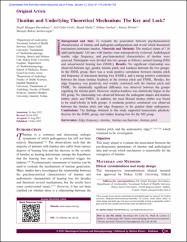| dc.contributor.author | Mungan Durankaya, Serpil | |
| dc.contributor.author | Çakır Çetin, Aslı | |
| dc.contributor.author | Mutlu, Başak | |
| dc.contributor.author | Gürkan, Selhan | |
| dc.contributor.author | Kırkım, Günay | |
| dc.contributor.author | Şerbetçioğlu, Mustafa Bülent | |
| dc.date.accessioned | 2023-01-13T10:43:44Z | |
| dc.date.available | 2023-01-13T10:43:44Z | |
| dc.date.issued | 2022 | en_US |
| dc.identifier.citation | Mungan Durankaya, S., Çakır Çetin, A., Mutlu, B., Gürkan, S., Kırkım, G. ve Şerbetçioğlu, M. B. (2022). Tinnitus and underlying theoretical mechanism: The key and lock? Neurological Sciences and Neurophysiology, 39(4), 183-190. https://dx.doi.org/10.4103/nsn.nsn_55_22 | en_US |
| dc.identifier.issn | 2636-865X | |
| dc.identifier.uri | https://dx.doi.org/10.4103/nsn.nsn_55_22 | |
| dc.identifier.uri | https://hdl.handle.net/20.500.12511/10308 | |
| dc.description.abstract | Background and Aim: To evaluate the association between psychoacoustical characteristics of tinnitus and audiogram configurations and reveal which theoretical mechanism dominates tinnitus. Materials and Methods: The medical charts of 110 adult participants' 164 ears with tinnitus were retrospectively reviewed. Audiological results, edge frequency, and psychoacoustical characteristics of tinnitus were assessed. Participants were divided into two groups as follows: normal hearing (NH) and sensorineural hearing loss (SNHL). Results: No significant relationship was observed between age, gender, tinnitus pitch, and loudness between the two groups. In the SNHL group, there was a weak positive correlation between tinnitus pitch and frequency of maximum hearing loss (FMHL), and a strong positive correlation between the mean tinnitus loudness at the tinnitus pitch and FMHL. Besides, the edge frequency was positively and weakly correlated with the tinnitus pitch and FMHL. No statistically significant difference was observed between the groups regarding the tinnitus pitch. However, tinnitus loudness was statistically higher in the NH group. No relationship was observed between the audiogram shapes and tinnitus timbre, pitch, and FMHL. In addition, the most likened tinnitus timbre was found to be tonal/whistle in both groups. A moderate positive correlation was observed between the tinnitus pitch and edge frequency in the gradual slope audiograms. Conclusions: The findings obtained in this study supported homeostatic plasticity theories for the SNHL group, and hidden hearing loss for the NH group. | en_US |
| dc.language.iso | eng | en_US |
| dc.publisher | Wolters Kluwer Medknow Publications | en_US |
| dc.rights | info:eu-repo/semantics/openAccess | en_US |
| dc.rights | Attribution-NonCommercial-ShareAlike 4.0 International | * |
| dc.rights.uri | https://creativecommons.org/licenses/by-nc-sa/4.0/ | * |
| dc.subject | Edge Frequency | en_US |
| dc.subject | Tinnitus | en_US |
| dc.subject | Tinnitus Mechanisms | en_US |
| dc.subject | Tinnitus Pitch | en_US |
| dc.title | Tinnitus and underlying theoretical mechanism: The key and lock? | en_US |
| dc.type | article | en_US |
| dc.relation.ispartof | Neurological Sciences and Neurophysiology | en_US |
| dc.department | İstanbul Medipol Üniversitesi, Sağlık Bilimleri Fakültesi, Odyoloji Bölümü | en_US |
| dc.authorid | 0000-0002-5985-097X | en_US |
| dc.identifier.volume | 39 | en_US |
| dc.identifier.issue | 4 | en_US |
| dc.identifier.startpage | 183 | en_US |
| dc.identifier.endpage | 190 | en_US |
| dc.relation.publicationcategory | Makale - Uluslararası Hakemli Dergi - Kurum Öğretim Elemanı | en_US |
| dc.identifier.doi | 10.4103/nsn.nsn_55_22 | en_US |
| dc.institutionauthor | Şerbetçioğlu, Mustafa Bülent | |
| dc.identifier.wosquality | Q4 | en_US |
| dc.identifier.wos | 000970788600003 | en_US |
| dc.identifier.scopus | 2-s2.0-85145469335 | en_US |
| dc.identifier.scopusquality | Q3 | en_US |



















